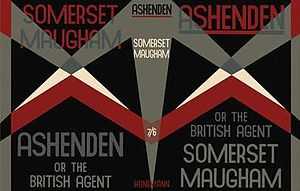Ashenden: Or the British Agent

Ashenden: Or the British Agent is a 1928 collection of loosely linked stories by W. Somerset Maugham. It is partly based on the author's experience as a member of British Intelligence in Europe during the First World War.
Plot summary
A playwright called Ashenden is recruited by Colonel R., a British Intelligence officer. He is sent to Switzerland where he becomes involved in a series of adventures. In one he accompanies a man called the Hairless Mexican to Italy, where a Greek agent of the Germans is to be assassinated. In another he must persuade an Italian dancer to induce her Indian lover, a German agent, to cross the border from neutral Switzerland to see her in allied France, so that Ashenden can arrest him.
Chapters
- R.
- A Domiciliary Visit
- Miss King
- The Hairless Mexican
- The Dark Woman
- The Greek
- A Trip to Paris
- Giulia Lazzari
- Gustav
- The Traitor
- Behind the Scenes
- His Excellency
- The Flip of a Coin
- A Chance Acquaintance
- Love and Russian Literature
- Mr. Harrington's Washing
The chapters are collected in later collections under different titles, as below. It is unknown whether they were rewritten slightly from original publication.
- "A Domiciliary Visit" & "Miss King" as Miss King
- "The Hairless Mexican", "The Dark Woman", "The Greek" as The Hairless Mexican
- "A Trip to Paris, "Giulia Lazzari" as Giulia Lazzari
- "Gustav", "The Traitor" as The Traitor
- "Behind the Scenes", "His Excellency", as His Excellency
- "A Chance Acquaintance", "Love and Russian Literature", "Mr. Harrington's Washing" as Mr. Harrington's Washing
Origins
It is said that Somerset Maugham modelled the character of Ashenden after himself. He is supposed to have modelled Chandra Lal after Virendranath Chattopadhyaya, an Indian Nationalist in Germany during the war.[1] Maugham, who was in the British Secret Service in Europe during the war, based a number of his stories on his own experiences. Among other enterprises, Britain's European intelligence network attempted to eliminate a number of Indian nationalists in Europe, notably members of the Berlin Committee. Donald Gullick, a British agent, was dispatched to assassinate Chattopadhaya while the latter was on his way to Geneva to meet another Indian nationalist, Mahendra Pratap and forward the Kaiser's invitation to Berlin. The short story of Giulia Lazzari is a blend of Gullick's attempts to assassinate Chattopadhyaya and Mata Hari's story. Winston Churchill reportedly advised Maugham to burn 14 other stories.[2][3]
Literary significance and criticism
It is an archetype of the espionage novel, a book to which more contemporary practitioners such as Eric Ambler, Dennis Wheatley, Ian Fleming, Leslie Charteris, Graham Greene, Len Deighton, John le Carré, and Alan Furst are indebted for its role in developing the genre.. An example of this is the device, which Fleming copied in the James Bond novels, of referring to the head of British Intelligence only by an initial. In fact, the director of MI6 has always been known as "C", supposedly for "chief", but actually because the first director, Sir Mansfield Smith-Cumming, signed departmental paperwork with that initial.
Film and TV adaptations
The 1936 Alfred Hitchcock-directed film Secret Agent was a loose adaptation of "The Traitor" and "The Hairless Mexican", with John Gielgud as Ashenden (whose "real" name is Edgar Brodie), and Peter Lorre as The General. In the 1950 anthology film Trio, Ashenden was played by Roland Culver in the third story called Sanatorium. In 1959 Stephen Murray stared as Ashenden in The Traitor a movie made for BBC TV.
A number of the stories formed the basis of the 1991 four-part BBC1 series Ashenden, directed by Christopher Morahan, with Alex Jennings in the title role, Joss Ackland as Cumming and Ian Bannen as 'R'. Guest actors included Harriet Walter as Giulia Lazzari in the first episode, Alan Bennett as Grantly Caypor in the second, and Alfred Molina as Carmona, the titular character in the final story. A framing device at the start of each episode shows progressively more of an aged Ashenden living in France in the mid-1960s, reacting adversely to a piece of music on the radio. The final episode – which gives the context to this reaction – closes with a return to this "future" setting.
- "The Dark Woman" (17 November 1991)
- "The Traitor" (24 November 1991)
- "Mr Harrington's Washing" (1 December 1991)
- "The Hairless Mexican" (8 December 1991)
Other appearances
Ashenden is the narrator of Maugham's novels Cakes and Ale, The Moon and Sixpence and The Razor's Edge..[4] The character appears briefly in the book The Bloody Red Baron by Kim Newman
References
- ↑ Balachandran, V. (28 August 2011). "True fiction: The best spies are really quite boring". Sunday Guardian. Retrieved 23 August 2013.
- ↑ Popplewell 1995, p. 234
- ↑ Barooah 2004
- ↑ Kathleen Kuiper, Cakes and Ale (novel by Maugham). Britannica.com, 2011. Accessed 23 November 2013.
External sources
- Barooah, N.K (2004), Chatto: The Life and Times of an Anti-Imperialist in Europe., Oxford University Press, USA., ISBN 0-19-566547-3.
- Popplewell, Richard J (1995), Intelligence and Imperial Defence: British Intelligence and the Defence of the Indian Empire 1904–1924., Routledge, ISBN 0-7146-4580-X.
| ||||||||||||||||||||||